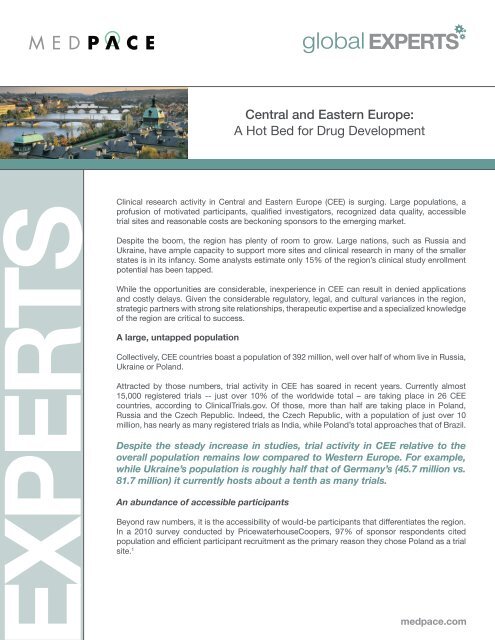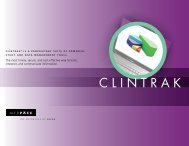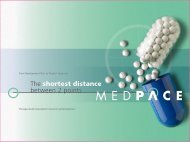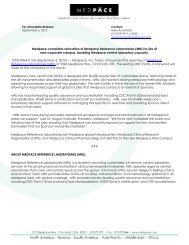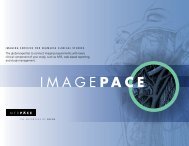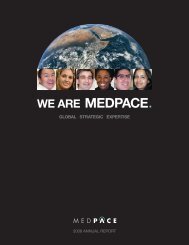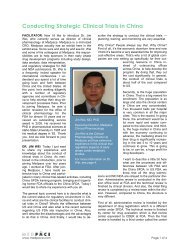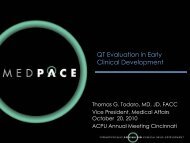global - Medpace
global - Medpace
global - Medpace
You also want an ePaper? Increase the reach of your titles
YUMPU automatically turns print PDFs into web optimized ePapers that Google loves.
<strong>global</strong><br />
Central and Eastern Europe:<br />
A Hot Bed for Drug Development<br />
Clinical research activity in Central and Eastern Europe (CEE) is surging. Large populations, a<br />
profusion of motivated participants, qualified investigators, recognized data quality, accessible<br />
trial sites and reasonable costs are beckoning sponsors to the emerging market.<br />
Despite the boom, the region has plenty of room to grow. Large nations, such as Russia and<br />
Ukraine, have ample capacity to support more sites and clinical research in many of the smaller<br />
states is in its infancy. Some analysts estimate only 15% of the region’s clinical study enrollment<br />
potential has been tapped.<br />
While the opportunities are considerable, inexperience in CEE can result in denied applications<br />
and costly delays. Given the considerable regulatory, legal, and cultural variances in the region,<br />
strategic partners with strong site relationships, therapeutic expertise and a specialized knowledge<br />
of the region are critical to success.<br />
A large, untapped population<br />
Collectively, CEE countries boast a population of 392 million, well over half of whom live in Russia,<br />
Ukraine or Poland.<br />
Attracted by those numbers, trial activity in CEE has soared in recent years. Currently almost<br />
15,000 registered trials -- just over 10% of the worldwide total – are taking place in 26 CEE<br />
countries, according to ClinicalTrials.gov. Of those, more than half are taking place in Poland,<br />
Russia and the Czech Republic. Indeed, the Czech Republic, with a population of just over 10<br />
million, has nearly as many registered trials as India, while Poland’s total approaches that of Brazil.<br />
Despite the steady increase in studies, trial activity in CEE relative to the<br />
overall population remains low compared to Western Europe. For example,<br />
while Ukraine’s population is roughly half that of Germany’s (45.7 million vs.<br />
81.7 million) it currently hosts about a tenth as many trials.<br />
An abundance of accessible participants<br />
Beyond raw numbers, it is the accessibility of would-be participants that differentiates the region.<br />
In a 2010 survey conducted by PricewaterhouseCoopers, 97% of sponsor respondents cited<br />
population and efficient participant recruitment as the primary reason they chose Poland as a trial<br />
site. 1<br />
medpace.com
Page 2 of 6<br />
<strong>global</strong><br />
CEE residents are often eager to participate in research studies because trials provide access to<br />
advanced therapies and to service that can be difficult to attain under the various nations’ standard<br />
health care systems. Because many patients are under treated, they are free from confounding<br />
medications that could preclude them from trial participation. Additionally, pockets of the region<br />
have especially high rates of certain conditions, which facilitate trial recruitment in those areas.<br />
Poland, for example, has high cancer rates.<br />
Much of the CEE population is concentrated in large urban centers such as Moscow (nearly 12<br />
mln), Saint Petersburg (5 mln), Kiev (2.8 mln), Warsaw (1.8 mln) and Budapest (1.7 mln). These cities<br />
are home to the large, therapeutically specialized hospitals that characterize the centralized public<br />
healthcare systems in the CEE. The hospitals provide a critical referral network for trials as well as<br />
comprehensive patient records.<br />
Collectively, these forces speed and facilitate participant enrollment. One study that analyzed<br />
enrollment data from 50 international phase II and III clinical trials estimated that site productivity<br />
(measured as monthly enrollment per site) in Russia, Ukraine, and the Balkans is more than twice<br />
that of Western Europe and the United States. 2<br />
These same trends promote easier long-term follow-up and lower drop out rates. Residents of CEE<br />
states tend to be less mobile than those of Western countries and the availability of patients’ medical<br />
histories is also associated with lower screening failure and premature withdrawal rates. 3<br />
Logistical appeal<br />
Clinical activity in the CEE countries is concentrated in the major cities, which are easily accessible<br />
by air and rail. These urban hubs likewise offer a network of service providers, such as translation<br />
services and warehouses. Many of these services have emerged to meet the demands of the growing<br />
research market.<br />
Unlike emerging markets in China or India, research sites in CEE are in the same or proximate<br />
time zones as major cities in Western Europe and are only a short plane ride away. That proximity<br />
promotes communication across trial sites, which can enhance overall trial efficiency.<br />
Qualified investigators, data quality<br />
CEE countries have a reputation for conducting high quality clinical research due in part to a cadre of<br />
highly trained investigators and an emphasis on data quality. Solid training facilities and progressive<br />
attitudes toward education in the region have produced a highly qualified cadre of investigators.<br />
What’s more, with the steady increase of clinical trial activity in countries such as Poland over the<br />
last two decades, investigators have developed extensive experience.<br />
Research based on FDA inspections during Investigational New Drug studies from 1994 (when the<br />
FDA first performed inspections in CEE) and 2010 found CEE sites out performed U.S. and Western<br />
European sites in terms of regulatory compliance and data quality. In analyzing nearly 4,900 routine<br />
data audit inspections, from the various regions researchers found CEE sites had fewer deficiencies<br />
per inspection (0.99) than the United States (1.59) or Western Europe (1.99). What’s more 39% of<br />
CEE inspections found no deficiencies compared to 21.5% of inspections in the United States and<br />
just 16.6% of those in Western Europe.<br />
medpace.com
Page 3 of 6<br />
<strong>global</strong><br />
The CEE also had the highest percentage of inspections after which no follow-up action was<br />
indicated and the lowest percentage of inspections that required official or voluntary action. While<br />
the data may be biased – the FDA was far more likely to conduct routine audits of U.S. sites -- the<br />
findings support the reliability of CEE data. 5<br />
Sources: ClinicalTrials.gov, 2/21/13; World Bank<br />
* Member of the European Union<br />
** Expected to join the European Union in mid 2013.<br />
http://www.ncbi.nlm.nih.gov/pmc/articles/PMC3340105/table/t4-dddt-6-053/ >><br />
medpace.com
Page 4 of 6<br />
<strong>global</strong><br />
Standards and regulatory rigor<br />
Ten countries in the CEE are currently part of the European Union (EU). From a sponsor’s perspective<br />
EU membership is advantageous because countries adhere to a harmonized, familiar legislative<br />
framework and are subject to well established EU regulations regarding Good Clinical Practice<br />
(GCP) standards and predictable processes.<br />
The adoption of EU standards has propelled trial activity in these countries. In the survey conducted<br />
by PricewaterhouseCoopers, for example, 94% of sponsor respondents cited ensured EU standards<br />
and high quality data as central to their decision to conduct trials in Poland.<br />
Challenges remain<br />
While CEE states present ample opportunities, sponsors new to the region<br />
face daunting administrative, regulatory, logistical and ethical challenges.<br />
Allying with a seasoned strategic partner with clinical experience in CEE is<br />
essential.<br />
Logistically it can be difficult to find central laboratories capable of addressing critical trial<br />
requirements in a standardized manner. Conducting trials outside major cities can be prohibitive<br />
due to lack of basic infrastructure. Identifying therapeutically excellent strategic partners with <strong>global</strong><br />
capabilities is a major challenge. While a proliferation of local clinical research organizations (CROs)<br />
have cropped up throughout the region in recent years, few have the ability to coordinate CEE sites<br />
with the balance of a <strong>global</strong> trial.<br />
Jeremy Spivey, senior research analyst at Cutting Edge Information, a business intelligence firm<br />
specializing in the life sciences industry, notes that site contracting in Poland is especially complex.<br />
“If this is not handled by a CRO with a preferred vendor network it can take up to six months to get<br />
your trial started just by your handling the contracting elements of trial sites,” he observes in a web<br />
presentation on the topic. 6<br />
Regulatory challenges persist as well. Even though Poland is part of the EU and subject to a 60 day<br />
regulatory approval requirement, approvals there can still lag.<br />
Leveraging existing site relationships is essential to addressing these<br />
challenges. Tapping existing relationships can shorten learning curves for<br />
all parties, expedite study start-up times, and ensure ethical conduct and<br />
regulatory compliance.<br />
Regulatory challenges persist as well. Even though Poland is part of the EU and subject to a 60 day<br />
regulatory approval requirement, approvals there can still lag.<br />
<strong>Medpace</strong> experience in CEE<br />
<strong>Medpace</strong> has been conducting clinical trials in CEE since 2006. Our established site relationships,<br />
specialized regulatory knowledge, therapeutic expertise and proactive approach to clinical trial<br />
management enable us to leverage the benefits of the region while successfully navigating the<br />
challenges.<br />
medpace.com
Page 5 of 6<br />
<strong>global</strong><br />
<strong>Medpace</strong> brings a comprehensive array of resources to bear on every clinical trial:<br />
• Country-specific regulatory expertise. <strong>Medpace</strong> Medical Consulting (MMC) provides<br />
comprehensive regulatory services at both the national and EU level. The MMC team has<br />
in-depth experience working CEE authorities and addressing the entire spectrum of regulatory<br />
requirements pertaining to submissions, quality, pre-clinical and clinical studies. By tapping<br />
MMC’s R&D consulting services while planning studies in CEE, sponsors can avoid expensive<br />
detours and regulatory dead ends.<br />
• Therapeutic leadership. <strong>Medpace</strong> embeds therapeutic experts into every research<br />
program to promote effective collaboration with sponsors and ultimately accelerate the<br />
drug approval process. Our growing list of therapeutic specialties includes Cardiology,<br />
Endocrine - Metabolic Disorders, Oncology, Infectious Disease and Vaccines, Nephrology,<br />
Central Nervous System, and Regenerative Medicine.<br />
• Longstanding site partnerships. Clinical research sites across the globe recognize<br />
<strong>Medpace</strong> as a valued partner. The International Society for Clinical Research Sites has<br />
twice honored <strong>Medpace</strong> with the Eagle Award in recognition of our leadership, professionalism,<br />
integrity, passion and dedication to advancing the clinical research profession through<br />
strong site partnerships. In addition, <strong>Medpace</strong> has been a provider for a key sponsors in need<br />
of project rescue based on slow patient enrollment having recently stepped in with key<br />
enrollment sites in Russia for a Phase III, Hypertriglyceridemia study.<br />
The clinical research sites with whom we work have deep roots in their local communities.<br />
Those ties expedite access to patients, facilitate rapid enrollment, reduce overall costs and<br />
enable us to address local issues in a knowledgeable, culturally sensitive way. Working with<br />
longstanding partners promotes effective communication, which is essential to managing<br />
<strong>global</strong> research.<br />
• <strong>Medpace</strong> Reference Laboratories (MRL). Accessing centralized lab services can be a<br />
major challenge in CEE. Our MRL is a <strong>global</strong> leader in providing customized, high-quality<br />
laboratory services to the pharmaceutical and biotech industries. With locations in Leuven,<br />
Belgium; Cincinnati, Ohio; Mumbai, India; and Beijing, China, our full-service central<br />
laboratories provide comprehensive, flexible laboratory services that maintain uniform<br />
instrumentation, reagents, calibration, and standard operating procedures (SOPs), essential<br />
to ensuring consist research quality.<br />
• Technologic advantages. ClinTrak ® , <strong>Medpace</strong>’s proprietary suite of innovative<br />
technologies, provides sponsors and study managers with real-time access to critical study<br />
data, including laboratory and imaging results, from around the globe. When conducting<br />
studies in multiple countries in CEE, robust technology like ClinTrak is critical for project<br />
management and communication.<br />
• Global technology platform. Our web-based, clinical trial technology platform improves<br />
operational efficiencies through consistent data and tracking regarding site performance,<br />
patient randomization, study enrollment, drug shipment tracking, specimen handling, and<br />
data and query. This capability is particularly advantageous when running trials across<br />
multiple countries.<br />
medpace.com
Page 6 of 6<br />
<strong>global</strong><br />
Conclusions<br />
Clinical trial activity in CEE, which has been building for years, is poised to accelerate. The countries<br />
of CEE offer such favorable conditions in terms of participant accessibility, large population pools,<br />
investigator quality, low costs and manageable logistics that sponsors interested in trial efficiency<br />
must consider them as site options. In doing so, however, sponsors must rely on experienced<br />
strategic partners. Successful clinical research in CEE depends on specialized understanding of<br />
the local market and regulatory climate and the ability to coordinate and manage local sites in the<br />
broader context of the <strong>global</strong> research process. Strategic research partners must have finely tuned<br />
local and <strong>global</strong> capabilities to overcome the myriad challenges of conducting trials in CEE and<br />
maximize their full potential.<br />
Sources:<br />
1, 4<br />
PriceWaterhouseCoopers. Clinical Trials in Poland: Key Challenges. November 2010<br />
2<br />
Tassignon J-P, Sinackevich N. Speeding the critical path. Applied Clinical Trials. 2004;13(1):42–48.<br />
3, 5<br />
Caldron PH, Gavrilova SI and Kropf S. Why (not) go east? Comparison of findings from FDA<br />
Investigational New Drug study site inspections performed in Central and Eastern Europe with<br />
results from the USA, Western Europe, and other parts of the world. Drug Design, Development and<br />
Therapy. 2012;6: 53–60. Published online 2012 March 27. The authors identified CEE countries as<br />
Bulgaria, Czech Republic, Croatia, Estonia, Hungary, Latvia, Lithuania, Poland, Romania, Russia,<br />
Slovenia, Serbia and Ukraine. http://www.ncbi.nlm.nih.gov/pmc/articles/PMC3340105/#b2-dddt-6-<br />
053#b2-dddt-6-053<br />
6, 7<br />
CEInsights: Conducting Clinical Trials in Central and Eastern Europe.<br />
medpace.com


